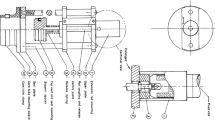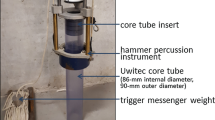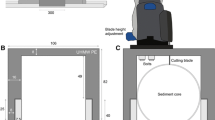Abstract
This commentary is intended as a practical guide for the non-motorized use of piston corers to obtain undisturbed sections of lake sediments. Good recovery is essential for accurate reconstruction of environmental and limnological history. Emphasis is placed on the square-rod piston corer, which is widely used for acquisition of sediment cores in meter-long sections from lakes as much as 30 m deep. Coring platforms for open water can be easily prepared on pairs of boats or canoes or (in water depth up to 15 m) even a single small rubber raft, but firm anchoring is essenial to maintain the vertical position of the casing and to assure re-entry into a single hole. Incomplete recovery on individual drives is not a result of sediment compaction but rather the build-up of friction on the tube interior, by which the core forms a plug that prevents further recovery.
Short cores of soft sediment for the study of recent changes in lakes are also best acquired with a piston corer, for a gravity corer without a piston may be subject to the same type of plug formation. In cases in which the structure of the sediment must be preserved (e.g. annual laminations), freezing the sediment in place with a dry-ice solution is the best procedure.
Similar content being viewed by others
References
Aaby, B. & B. Berglund, 1986. Sampling techniques for lakes and bogs. In B. Berglund, Editor, Handbook of Palaeoecology and Palaeohydrology, p. 181–194. New York, Wiley, 869 p.
Blomqvist, S., 1985. Reliability of core sampling of soft bottom sediment — an in situ study. Sedimentology 32: 605–612.
Blomqvist, S. & K. Bostrom, 1987. Improved sampling of soft bottom sediments by combined box and piston coring. Sedimentology 34: 715–719.
Digerfeldt, G., 1978. A simple corer for sediment sampling in deep water. University of Lund, Department of Quaternary Geology Report 14: 1–10.
Huttunen, P. & J. Meriläinen, 1975. Modification of a rodless core sampler for investigating lake sediments. Publications of the University of Joensuu BII4.
Jacobson, G. L. Jr. & R. H. W. Bradshaw, 1981. The selection of sites for paleovegetational studies. Quat. Res. 16: 80–96.
Livingstone, D. A., 1955. A lightweight piston sampler for lake deposits. Ecology 36: 139–141.
Renberg, I., 1981. Improved methods for sampling, photographing and varve-counting of varved lake sediments. Boreas 10: 255–258.
Wright, H. E. Jr., 1967. A square-rod piston sampler for lake sediments. J Sedim. Petrol. 37: 975–976.
Wright, H. E. Jr., 1980. Coring of soft lake sediments. Boreas 9: 107–114.
Wright, H. E. Jr., D. A. Livingstone & E. J. Cushing, 1965. Coring devices for lake sediments, In B. Kummel and D. M. Raup, Editors, Handbook of Paleontological Techniques, p. 494–520. San Francisco, W. H. Freeman Co., 852 p.
Wright, H. E. Jr., D. H. Mann, & P. H. Glaser, 1983. Piston corers for lake and wetland sediments. Ecology 65: 657–659.
Author information
Authors and Affiliations
Rights and permissions
About this article
Cite this article
Wright, H.E. Coring tips. J Paleolimnol 6, 37–49 (1991). https://doi.org/10.1007/BF00201298
Received:
Accepted:
Issue Date:
DOI: https://doi.org/10.1007/BF00201298




